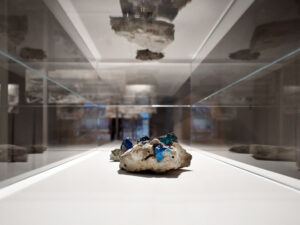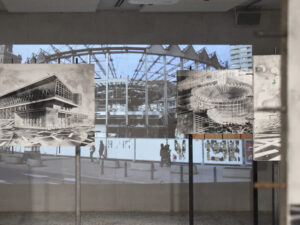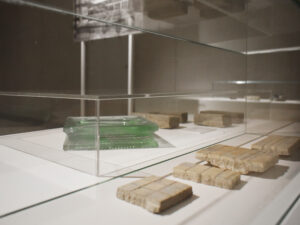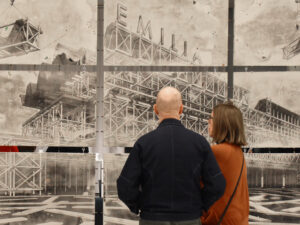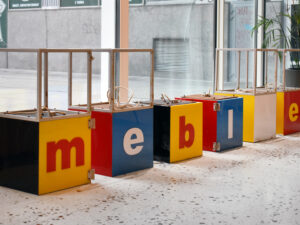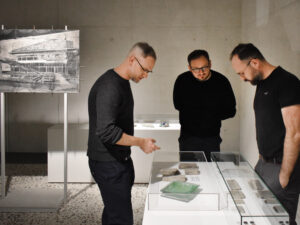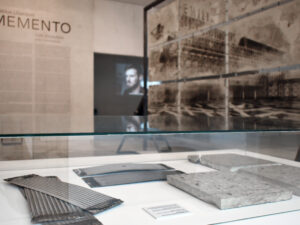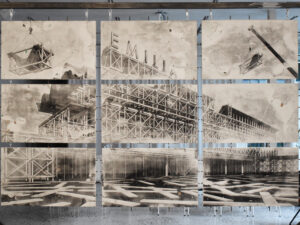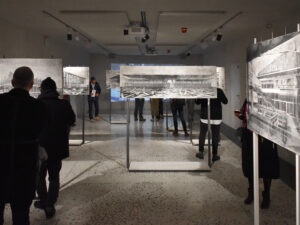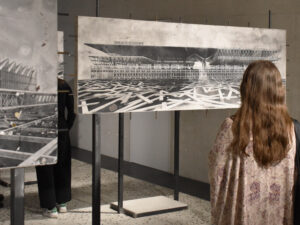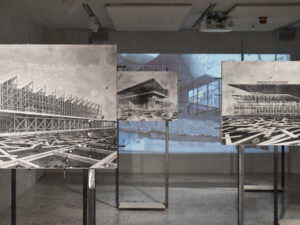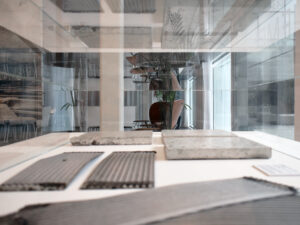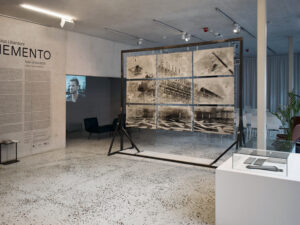
The public perception of the heritage of Polish post-war modernist architecture remains a complex issue. On the one hand, recent years have brought – in a discourse increasingly penetrating the mainstream – its recognition, honouring, appreciation. On the other hand, the same period has taken (and continues to take) a devastating toll. Modernist works, which were created in the 1960s and 1970s, have successively disappeared from the streets of our cities over the past decades, or have undergone metamorphoses from which the former designs, full of lightness and precision, are hardly recognizable. In some cases this was accompanied by loud protests, in others it took place in complete silence.
“Memento” is a way of commemorating – or perhaps sometimes “reminding”? – of icons that no longer exist or are completely unlike themselves. In a series of monochromatic prints, Brazilian-Italian artist and architect Vinicius Libardoni portrays post-war edifices from various Polish cities, while poetically conveying the paradox of their fate. The brutalistic Katowice train station, “Emilia” furniture pavilion or Supersam in the oneiric paintings are torn from their surroundings, abstracted from their urban context. This is a disturbing study of their decay: lonely and abandoned they barely stand, cracking, crumbling, settling into the rubble that surrounds them from all sides. However, even in this gloomy state, they do not cease to impress with their fine form – a sophisticated play of geometric shapes.
Dystopian landscapes not only blur the boundaries between reality and a fever dream, but also between art and architecture. “Memento” is a series of works rooted in the tradition of printmaking and drawing on its most classical techniques; at the same time, Libardoni’s experimental formal strategy draws directly from the practice of the construction site. The artist creates stories of architectural heritage using a language specific to this field: his intricate drawings are etched on raw reinforced concrete slabs. This gives the flat images depth and texture, the simplicity and sincerity of the material emphasize their artistry, while at the same time bringing them closer to bas-reliefs made with the noble techniques of architectural art. The multi-level relationship between the two disciplines that meet here is reinforced by the structure of the exhibition – massive objects like walls fence off the space, dividing it into a sequence of interiors dedicated to individual monuments of modernism. They are accompanied by the remains of demolished buildings and film documentation of the demolitions: material remnants of the lost objects.
The most recent work on display is the one portraying the building designed by Jan Bogusławski and Bohdan Gniewiewski, whose creative reconstruction is ZODIAK Warsaw Pavilion of Architecture. It is a separate work from the rest, told by slightly different means and presented in a special way. This should not come as a surprise, since the story of the object it evokes is different from the others: surprising, not obvious, with a heartening finale. It illustrates how the discussion on managing the legacy of post-war Polish architectural thought has evolved over the decades.
Despite the fact that the modernist buildings shown in the exhibition have disappeared from the maps, the memory of them has not faded. Building materials, fragments of decoration or interior furnishings have found a second life in new projects or have become elements of various collections. We present some of them in the exhibition: some artifacts are part of the “Architectural Transplantations” collection of the Centrala studio and Aleksandra Kędziorek, while others come from the archives of the Capital Heritage Protection Department.
Colophon:
Organizer: City of Warsaw
Artist: Vinicius Libardoni
Curator: Kuba Żary
Production: Vinicius Libardoni, Kuba Żary, Monika Komorowska, Katarzyna Sałbut, Artur Wosz, Katarzyna Zachara
Visual identification: Sara Makuch
Partners: Wrocław Film Foundation, Museum of Architecture
Acknowledgements: Office of the Capital Conservator of Monuments, Michał Krasucki, Centrala (Małgorzata Kuciewicz, Simone De Iacobis), Aleksandra Kędziorek



